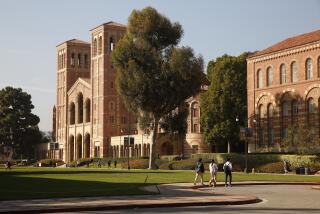Europe’s Expected Good Fortune Will Benefit U.S. Too
- Share via
Suddenly the economic focus is shifting to Europe--big changes in Eastern Europe coming on top of changes in Western Europe, where 12 countries plan to unify their markets in 1992.
A big question is what it all means for the United States.
For the record:
12:00 a.m. Nov. 16, 1989 For the Record
Los Angeles Times Thursday November 16, 1989 Home Edition Business Part D Page 2 Column 3 Financial Desk 1 inches; 24 words Type of Material: Correction
New Perspective Fund--In James Flanigan’s column Wednesday, the name of a Capital Research mutual fund was incorrectly stated. The correct name is New Perspective Fund.
It means opportunity all around. For Europe, first, it means a multiplying of economic growth, the equivalent of taking steroids along with vitamins. The opening of new markets in the East will add to quickening growth in the West--making the old Continent perhaps the fastest growing part of the industrial world in the early 1990s.
Europe was already recovering, spurred by the promise of freer movement of goods, capital and people across its many borders in 1992 when the countries implement a program of economic unification. Where the economies of France, West Germany, Italy and other European Community, or EC, countries had lagged behind U.S. growth through most of the 1980s, they are now growing faster--3% to 4% a year, compared to 2.5% for the U.S. economy. In the early ‘90s, the Europeans are projected to continue outpacing U.S. growth.
And to that emerging EC market of 323 million people, Eastern Europe now may add 140 million customers--400 million if you include the Soviet Union. “The prospect only adds to the self-confidence you see in Europe today,” says a European economist.
Yet there’s no reason for lack of confidence in the United States. Since the Europeans started passing laws in 1987 to create a single market, there have been misgivings in the United States--suspicions that the EC was building a wall around itself even higher than that of the 32-year-old Common Market.
But suspicions are not supported by the record. Trade figures show that over the years Europe has been a better market for U.S. exports than Japan, the big and supposedly open economy of Asia. For the last 10 years consistently, the European Community has taken more than 23% of U.S. exports and contributed more than 20% of its imports. Japan, by contrast, has taken on average 9% of U.S. exports each year, but sent in an average 18% of its imports.
And the fear that the EC will now turn to adversarial trade like Japan is mistaken. “The idea of 1992 is cost reduction, trying to bring to Europe the efficiencies of the U.S. and Japan,” says mutual fund manager Penny Dobkin, who oversees the $97-million Europe Fund for Fidelity Investments.
The idea arose in worried meetings in Brussels in 1986 when the EC feared its economies could grind to a halt, as Eastern Europe’s have recently done. At the time, “Eurosclerosis” was the word Europeans used to describe their economy. Unemployment stood at double digits in most countries, yet absenteeism rates among workers who had protected jobs also ran above 10%. The problem was each country favored its own markets, restricted movement of currency, food products, road traffic, you name it. It was as if the 50 U.S. states erected customs posts at every state line.
The unified market of 1992 is designed to cure Eurosclerosis. Productivity will improve as shipments that now take three days to cross Europe will get there in two, as unemployed workers can more easily cross borders to seek jobs.
And, unforeseen, the East now promises a new dimension, a growth market, hungry for consumer goods. The old Continent’s cup runneth over.
But the opportunities are not restricted to Europeans. Many U.S. companies are already strong in Europe--in chemicals and pharmaceuticals, where Dow, Merck, DuPont, Upjohn and many others get a third of their business--and in computers. In picking companies to benefit from 1992, the global mutual fund managers at Capital Research’s $1-billion New Directions Fund looked first to such U.S. firms as Apple, IBM and Digital Equipment (as they also looked to Hitachi and Kyocera of Japan).
Other U.S. companies are expanding in Europe. Intel recently committed to a 10-year $400-million investment in a manufacturing center in Ireland to serve European customers--who provide more than 25% of its business. Whirlpool this year formed a joint venture with Philips of Holland to push its appliances into European homes; General Electric did the same with its unrelated namesake, General Electric Corp. of Britain.
Some parts will be produced in America, some will be produced in Europe. The pattern is multinational contribution, multinational benefit, says Bjorn Ahlstrom, head of North American operations for Volvo, the Swedish car maker. He describes Volvo’s latest model to illustrate: “The Volvo 780,” says Ahlstrom, “is engineered in Sweden, designed and assembled in Italy, with a French engine, West German electronics, Irish tires, a Japanese transmission and a South Korean electrical harness. The air conditioning and fuel emission controls are American and the glass is Canadian.”
Such a car would never be built in the old days. But who says the old days were good days? Not Western Europe, and certainly not Eastern Europe. Their better days lie ahead.
More to Read
Inside the business of entertainment
The Wide Shot brings you news, analysis and insights on everything from streaming wars to production — and what it all means for the future.
You may occasionally receive promotional content from the Los Angeles Times.










